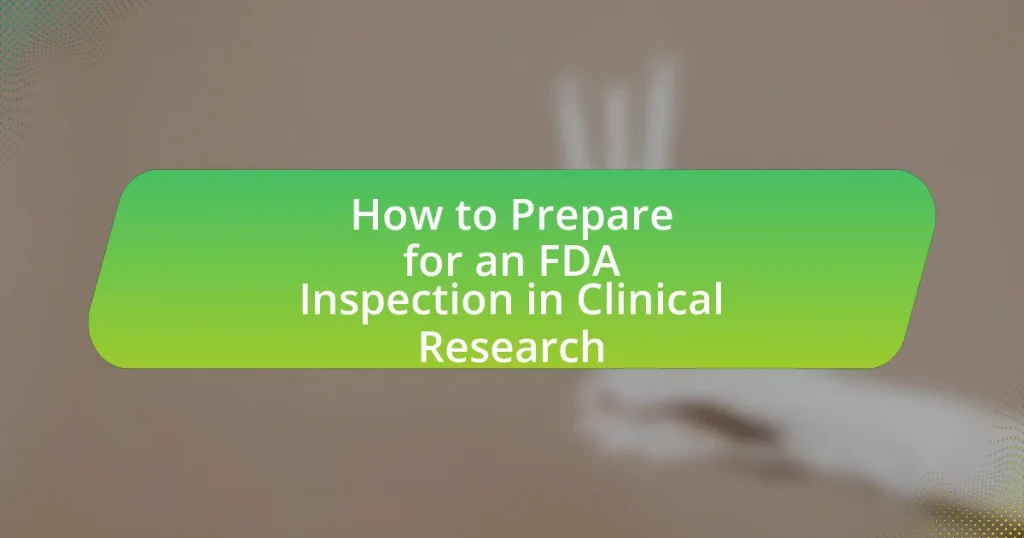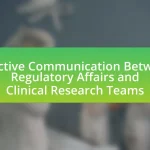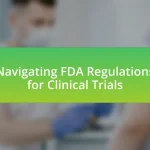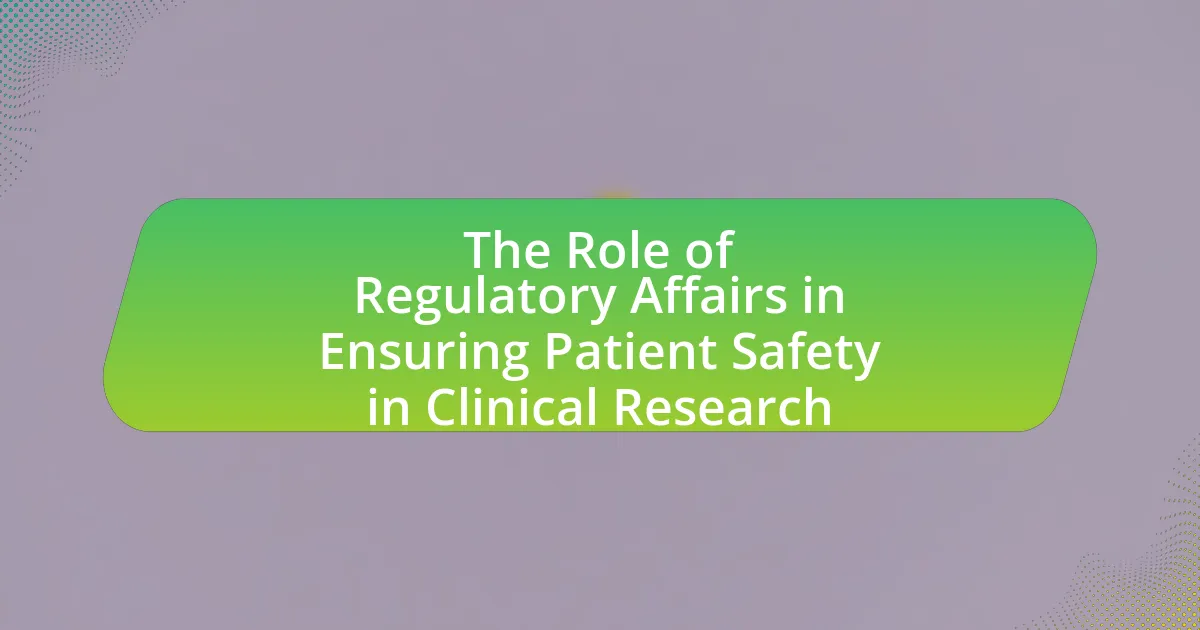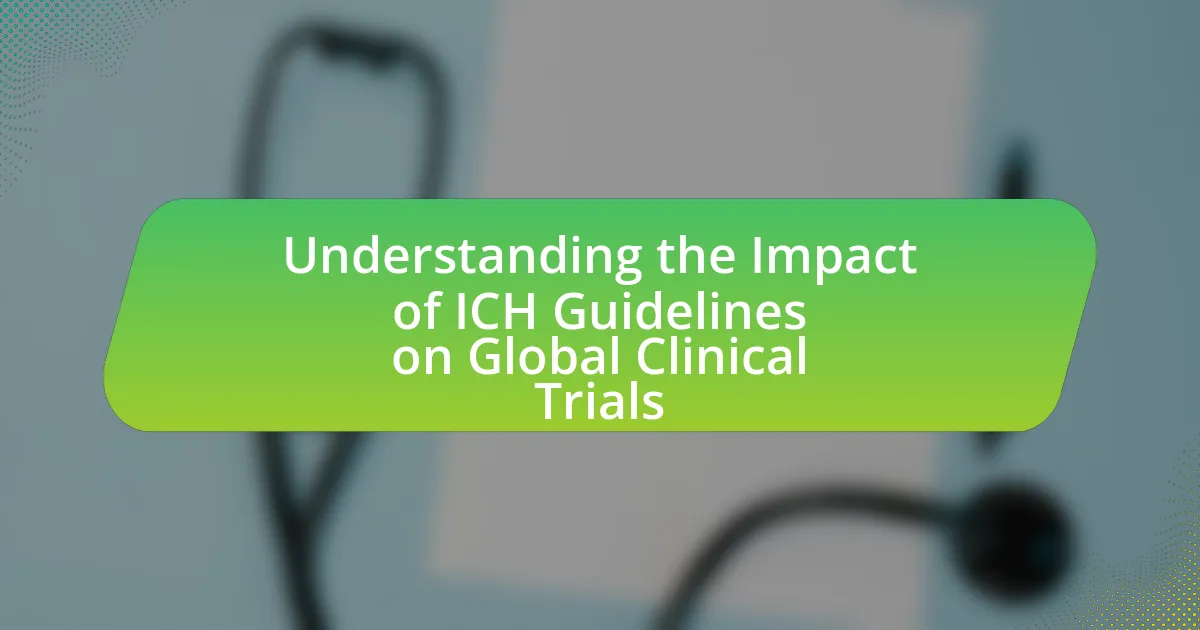The article focuses on the essential steps for preparing for an FDA inspection in clinical research, emphasizing the importance of compliance with regulatory standards. Key components of preparation include thorough documentation, staff training, and facility readiness, which collectively enhance the likelihood of a successful inspection outcome. The article also discusses the potential consequences of inadequate preparation, common challenges organizations face, and the role of communication in overcoming these challenges. Additionally, it highlights best practices during the inspection process and outlines necessary follow-up actions to address any findings, ultimately aiming to improve future inspection readiness.
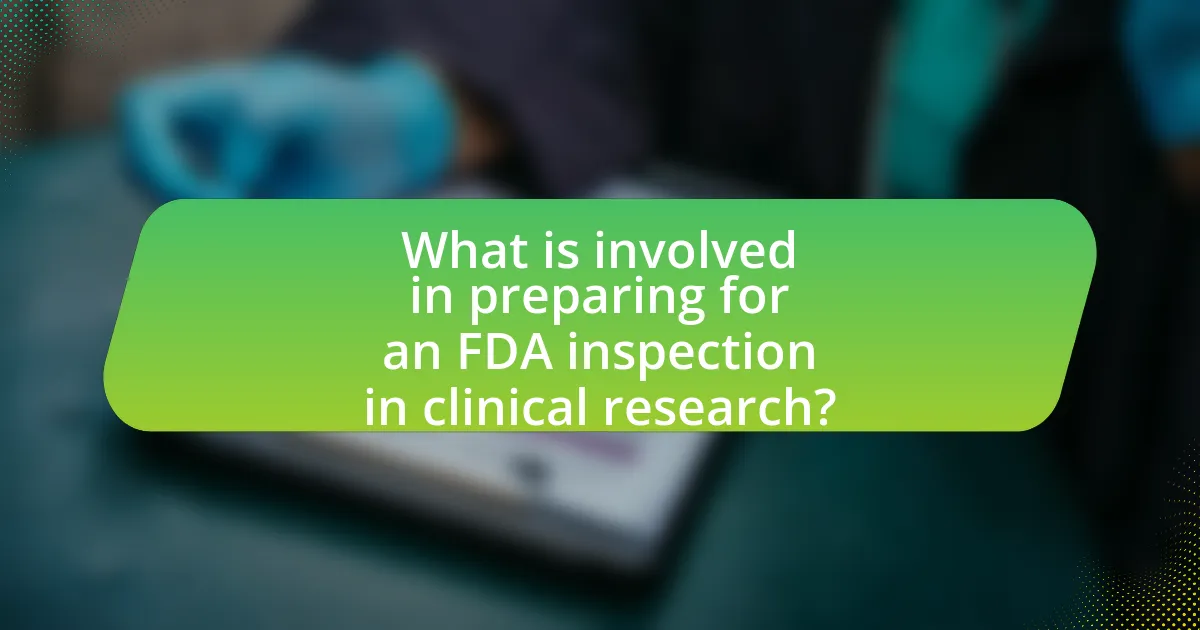
What is involved in preparing for an FDA inspection in clinical research?
Preparing for an FDA inspection in clinical research involves several key steps to ensure compliance with regulatory standards. First, organizations must conduct a thorough review of all study documentation, including protocols, informed consent forms, and case report forms, to ensure accuracy and completeness. Additionally, training staff on FDA regulations and inspection processes is crucial, as it prepares them to respond effectively during the inspection.
Moreover, conducting mock inspections can help identify potential issues and areas for improvement. It is also essential to ensure that all records are organized and readily accessible, as the FDA will review these documents during the inspection. Finally, maintaining open communication with the FDA and addressing any previous inspection findings demonstrates a commitment to compliance and quality in clinical research.
Why is preparation important for an FDA inspection?
Preparation is crucial for an FDA inspection because it ensures compliance with regulatory standards and minimizes the risk of violations. Effective preparation involves reviewing documentation, training staff, and ensuring that all processes meet FDA requirements, which can lead to a smoother inspection process. According to the FDA’s own guidelines, facilities that are well-prepared are more likely to demonstrate adherence to Good Manufacturing Practices (GMP), thereby reducing the likelihood of receiving warning letters or fines.
What are the potential consequences of inadequate preparation?
Inadequate preparation for an FDA inspection in clinical research can lead to significant consequences, including regulatory non-compliance, which may result in fines or sanctions. Specifically, organizations may face increased scrutiny from regulatory bodies, leading to potential delays in product approvals. Historical data indicates that facilities with poor preparation often receive Form 483 citations, which document violations of FDA regulations, impacting their reputation and operational capabilities. Furthermore, inadequate preparation can compromise patient safety and data integrity, ultimately affecting the validity of clinical trial results and leading to costly re-trials or loss of market access.
How can proper preparation impact the inspection outcome?
Proper preparation significantly enhances the inspection outcome by ensuring compliance with regulatory standards and minimizing potential findings. When clinical research teams thoroughly prepare for an FDA inspection, they can present organized documentation, demonstrate adherence to protocols, and effectively address any inquiries from inspectors. This proactive approach reduces the likelihood of negative observations, which can lead to delays in product approval or additional scrutiny. Studies indicate that well-prepared organizations experience fewer critical findings, as evidenced by a report from the FDA showing that facilities with comprehensive pre-inspection audits had a 30% lower rate of major violations compared to those without such measures.
What are the key components of FDA inspection preparation?
The key components of FDA inspection preparation include thorough documentation, staff training, and facility readiness. Documentation must encompass all relevant records, including study protocols, informed consent forms, and data management practices, ensuring compliance with FDA regulations. Staff training is essential to familiarize team members with inspection processes and their specific roles during the inspection. Facility readiness involves ensuring that the physical environment is clean, organized, and compliant with safety standards, as well as having all necessary equipment and materials readily accessible for review. These components collectively enhance the likelihood of a successful FDA inspection by demonstrating adherence to regulatory requirements and operational integrity.
What documentation is required for an FDA inspection?
For an FDA inspection, the required documentation includes the following: a copy of the clinical trial protocol, informed consent forms, case report forms, source documents, and records of any adverse events. Additionally, investigators must provide documentation of IRB approvals, regulatory submissions, and any correspondence with the FDA. These documents are essential for demonstrating compliance with Good Clinical Practice (GCP) and ensuring the integrity of the clinical trial data.
How should staff be trained for the inspection process?
Staff should be trained for the inspection process through comprehensive education on regulatory requirements and inspection protocols. This training should include detailed sessions on FDA guidelines, documentation practices, and the specific roles and responsibilities of each staff member during an inspection. Evidence from the FDA emphasizes that well-prepared staff can significantly reduce the risk of non-compliance and improve the overall inspection outcome. Regular mock inspections and scenario-based training can further enhance staff readiness, ensuring they are familiar with the inspection process and can effectively respond to inquiries.
What common challenges do organizations face during FDA inspections?
Organizations commonly face challenges such as inadequate documentation, lack of staff training, and insufficient quality control during FDA inspections. Inadequate documentation can lead to non-compliance findings, as the FDA requires thorough records to verify adherence to regulations. Lack of staff training often results in employees being unprepared to answer questions or provide necessary information, which can hinder the inspection process. Insufficient quality control measures may lead to product inconsistencies, raising concerns about safety and efficacy. These challenges can significantly impact an organization’s ability to demonstrate compliance and may result in regulatory actions.
How can organizations identify and address potential issues beforehand?
Organizations can identify and address potential issues beforehand by implementing proactive risk assessment strategies and conducting regular internal audits. These strategies involve evaluating processes, compliance with regulations, and identifying areas of vulnerability that could lead to non-compliance during FDA inspections. For instance, a study published in the Journal of Clinical Research found that organizations that conducted quarterly audits were 30% more likely to identify compliance issues before inspections compared to those that did not. This proactive approach allows organizations to rectify issues early, ensuring adherence to FDA standards and minimizing the risk of penalties or delays in clinical research.
What role does communication play in overcoming inspection challenges?
Communication is essential in overcoming inspection challenges by ensuring clarity, transparency, and collaboration among all stakeholders involved in the inspection process. Effective communication facilitates the sharing of critical information, which helps to address potential issues proactively and reduces misunderstandings that could lead to compliance failures. For instance, regular updates and open dialogue between clinical research teams and regulatory bodies can clarify expectations and requirements, ultimately leading to smoother inspections and better outcomes.
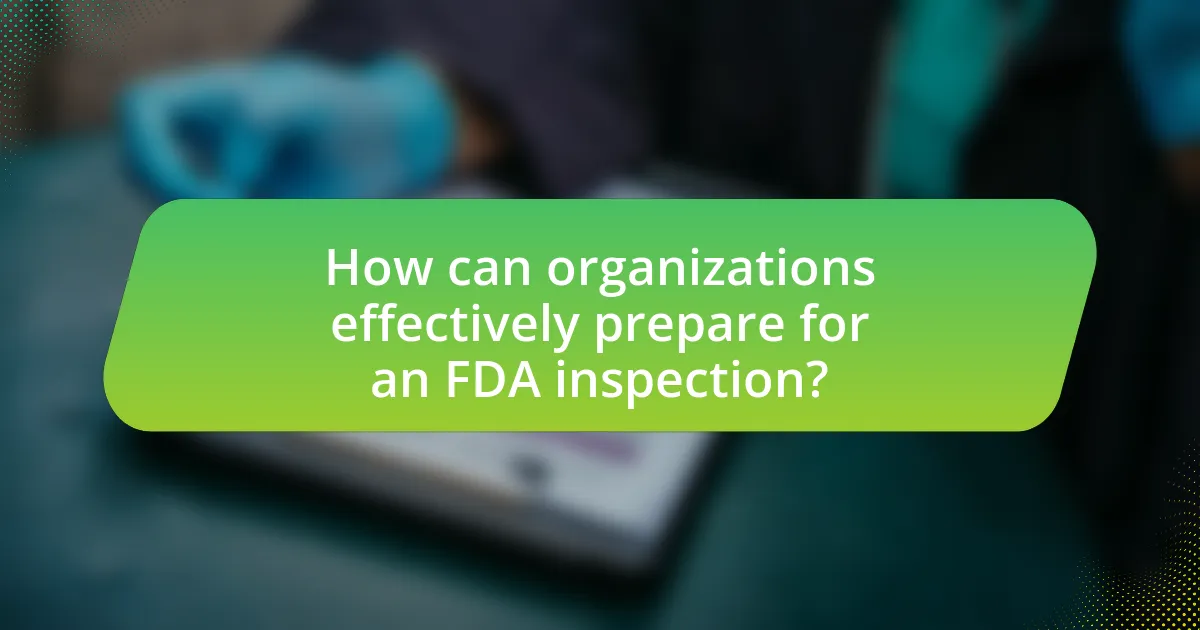
How can organizations effectively prepare for an FDA inspection?
Organizations can effectively prepare for an FDA inspection by implementing a comprehensive quality management system that includes regular internal audits, staff training, and thorough documentation practices. Regular internal audits help identify potential compliance issues before the inspection, allowing organizations to address them proactively. Staff training ensures that all employees understand FDA regulations and their specific roles during the inspection process. Thorough documentation practices, including maintaining accurate records of clinical trials and adhering to Good Clinical Practice (GCP) guidelines, provide evidence of compliance and facilitate a smoother inspection process. According to the FDA’s own guidelines, organizations that demonstrate a commitment to quality and compliance are more likely to achieve favorable inspection outcomes.
What steps should be taken to ensure readiness for the inspection?
To ensure readiness for the inspection, organizations must conduct a thorough pre-inspection review of all relevant documentation and processes. This includes verifying that all study records, informed consent forms, and regulatory submissions are complete and accurate. Additionally, staff should be trained on inspection protocols and their specific roles during the inspection process.
Regular mock inspections can also be beneficial, as they help identify potential issues and allow for corrective actions to be taken before the actual inspection. According to the FDA’s guidance on inspections, maintaining a well-organized and accessible filing system for all essential documents is crucial for demonstrating compliance and facilitating the inspection process.
How can a mock inspection help in preparation?
A mock inspection can significantly enhance preparation for an FDA inspection by simulating the actual inspection environment and processes. This practice allows clinical research teams to identify gaps in compliance, improve documentation practices, and refine responses to potential questions from inspectors. By conducting a mock inspection, organizations can receive immediate feedback on their readiness, which is crucial for addressing deficiencies before the official inspection occurs. Studies have shown that organizations that engage in mock inspections often experience higher compliance rates and fewer findings during actual inspections, demonstrating the effectiveness of this preparatory approach.
What checklists can be utilized to streamline the preparation process?
To streamline the preparation process for an FDA inspection in clinical research, several specific checklists can be utilized. These include the FDA Inspection Readiness Checklist, which outlines essential documents and processes that must be in place, such as informed consent forms, study protocols, and regulatory submissions. Another useful checklist is the Site Preparation Checklist, which ensures that all equipment, facilities, and personnel are ready for the inspection. Additionally, the Investigator Site File (ISF) Checklist helps verify that all necessary documentation is organized and accessible. Utilizing these checklists enhances compliance and readiness, as evidenced by studies showing that structured preparation significantly reduces inspection findings and improves overall outcomes in clinical trials.
What resources are available to assist in preparation for an FDA inspection?
Resources available to assist in preparation for an FDA inspection include the FDA’s own guidance documents, training programs, and checklists. The FDA provides comprehensive guidance documents that outline regulatory expectations and best practices for compliance, which can be accessed on their official website. Additionally, organizations such as the Clinical Research Associate (CRA) Association offer training programs specifically designed to prepare clinical research professionals for FDA inspections. Checklists created by industry experts can also serve as practical tools to ensure that all necessary documentation and processes are in place prior to an inspection. These resources collectively help organizations align with FDA standards and improve their readiness for inspections.
How can consulting services enhance the preparation process?
Consulting services can enhance the preparation process for an FDA inspection in clinical research by providing expert guidance and tailored strategies. These services offer insights into regulatory requirements, ensuring that organizations understand compliance standards and best practices. For instance, consulting firms often conduct mock inspections, which help identify potential gaps in documentation and processes, thereby allowing organizations to address issues proactively. Additionally, consulting services can facilitate training for staff on FDA regulations and inspection protocols, leading to improved readiness and confidence during the actual inspection. This structured approach has been shown to reduce the likelihood of non-compliance findings, as evidenced by studies indicating that organizations utilizing consulting services experience fewer regulatory issues compared to those that do not.
What role do training programs play in effective preparation?
Training programs play a crucial role in effective preparation for FDA inspections in clinical research by ensuring that staff are knowledgeable about regulatory requirements and best practices. These programs provide comprehensive education on compliance, protocols, and documentation standards, which are essential for passing inspections. Research indicates that organizations with structured training programs experience fewer compliance issues and improved inspection outcomes, as evidenced by a study published in the Journal of Clinical Research that found a 30% reduction in non-compliance incidents among trained staff compared to untrained personnel.
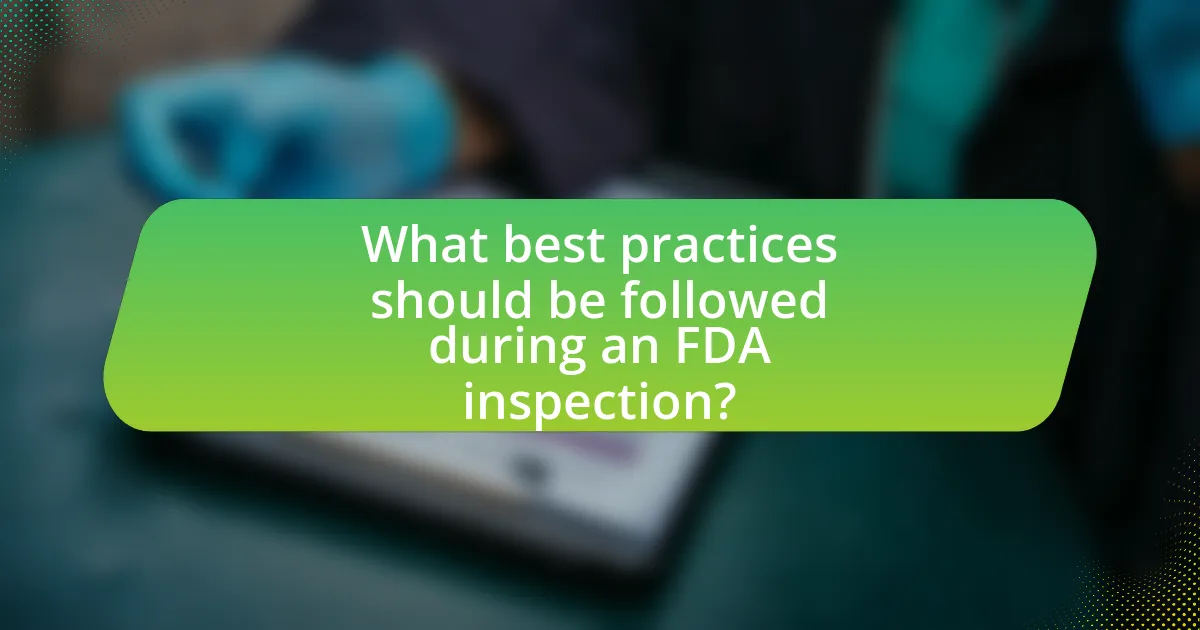
What best practices should be followed during an FDA inspection?
During an FDA inspection, best practices include being prepared, maintaining transparency, and ensuring compliance with regulations. Preparation involves having all necessary documentation readily available, such as study protocols, informed consent forms, and records of adverse events. Transparency is crucial; staff should be trained to answer questions honestly and accurately, as misleading information can lead to serious consequences. Compliance with FDA regulations must be demonstrated through adherence to Good Clinical Practice (GCP) guidelines, which are established to ensure the integrity of clinical trials. Following these practices can significantly enhance the inspection process and reduce the likelihood of findings that could impact the study’s credibility.
How should staff interact with FDA inspectors during the inspection?
Staff should interact with FDA inspectors during the inspection by being cooperative, transparent, and respectful. This means answering questions clearly, providing requested documents promptly, and maintaining a professional demeanor throughout the process. Effective communication is crucial; staff should ensure that they understand the inspectors’ inquiries and seek clarification if needed. According to FDA guidelines, a positive interaction can facilitate a smoother inspection process and demonstrate the organization’s commitment to compliance and quality.
What are the dos and don’ts of communication with inspectors?
The dos of communication with inspectors include being transparent, providing accurate information, and maintaining professionalism throughout the interaction. Transparency fosters trust, while accurate information ensures compliance with regulations. Professionalism reflects the seriousness of the inspection process and can positively influence the inspector’s perception.
The don’ts of communication with inspectors involve avoiding defensiveness, withholding information, and being disrespectful. Defensiveness can hinder open dialogue, withholding information can lead to compliance issues, and disrespect can damage relationships and credibility. These behaviors can negatively impact the outcome of the inspection.
How can organizations maintain a positive atmosphere during the inspection?
Organizations can maintain a positive atmosphere during the inspection by fostering open communication and demonstrating preparedness. Open communication allows staff to express concerns and ask questions, which can alleviate anxiety and build trust with inspectors. Preparedness, including thorough documentation and staff training, shows professionalism and confidence, contributing to a more relaxed environment. Research indicates that organizations that engage in proactive communication and training experience smoother inspections and better relationships with regulatory bodies, as highlighted in the FDA’s guidance on inspection readiness.
What follow-up actions are necessary after an FDA inspection?
After an FDA inspection, the necessary follow-up actions include addressing any observations noted by the FDA, implementing corrective actions, and submitting a response to the FDA if required. Observations, often referred to as Form 483, must be taken seriously, and organizations should develop a plan to rectify any identified issues within a specified timeframe. Additionally, maintaining documentation of all corrective actions and ensuring compliance with FDA regulations is crucial for future inspections. These steps are essential to demonstrate commitment to quality and regulatory adherence, as failure to adequately address findings can lead to further regulatory actions.
How should organizations respond to inspection findings?
Organizations should respond to inspection findings by promptly addressing the identified issues and implementing corrective actions. This involves conducting a thorough review of the findings, developing a detailed action plan to rectify deficiencies, and ensuring that all staff are trained on the necessary changes. According to the FDA’s guidance, timely and effective responses not only demonstrate compliance but also enhance the organization’s commitment to quality and safety in clinical research.
What steps can be taken to improve future inspection readiness?
To improve future inspection readiness, organizations should implement a comprehensive training program for staff on regulatory requirements and inspection processes. This training ensures that all team members understand their roles and responsibilities during an inspection, which is critical for compliance. Regular mock inspections can also be conducted to simulate the inspection environment, allowing teams to identify gaps in their processes and address them proactively. Additionally, maintaining thorough and organized documentation of all clinical trial activities is essential, as it provides clear evidence of compliance and facilitates a smoother inspection process. Research indicates that organizations with robust documentation practices experience fewer compliance issues during inspections, reinforcing the importance of this step.
What practical tips can enhance preparation for an FDA inspection?
To enhance preparation for an FDA inspection, organizations should conduct thorough internal audits to identify and rectify compliance gaps. Internal audits help ensure that all processes align with FDA regulations, which can significantly reduce the likelihood of findings during the actual inspection. Additionally, training staff on FDA requirements and inspection protocols is crucial, as knowledgeable personnel can effectively communicate and demonstrate compliance during the inspection. Maintaining organized and accessible documentation is also essential; having all necessary records readily available allows for a smoother inspection process. Furthermore, conducting mock inspections can provide valuable practice and highlight areas needing improvement, thereby increasing overall readiness. These strategies collectively contribute to a more successful FDA inspection outcome.
